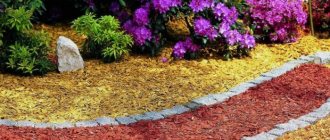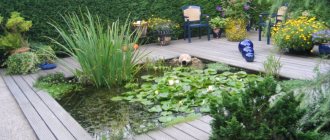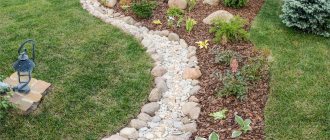Most summer residents strive to improve their garden, give it a well-groomed appearance, hence the desire to add something from landscape design to make the eye happy and the heart happy. You can line the paths with flat stones and install lanterns, but the real hit is still a decorative bridge for the dacha, assembled with your own hands and placed in the most visible place, usually in the floodplain of a dry or real stream. Many people think that this is unnecessary, but there is little work in such construction, but how much pleasure the process of building a decorative wooden bridge for the garden will bring.
A wooden bridge is best suited to the landscape at the dacha
What can you make a decorative bridge from?
Any attempts to assemble or build something on a dacha plot always ran into the problem of the dacha being unsettled and unsuitable. A country house is not a garage, not a carpentry shop or a metalworking workshop, so you can only count on working with hand-held carpentry power tools; you can also bring welding or a grinder if the network allows.
The second question is materials. Decorative bridges made of wood and natural stone look best on a summer cottage. This is still an element of landscape design, and not a full-fledged bridge. Although, if you make a real arched bridge over a stream or pond, then it is better to use metal, for example, weld a supporting frame from a square pipe or profile.
For unsupported arched structures, the best material is metal.
Therefore, the list of materials from which you can make a decorative garden bridge with your own hands will be quite short:
- Beams, logs, wooden slats and inch boards, all pre-sanded with an abrasive tape and treated with an antiseptic. We apply varnish or protective oil after assembling and installing the decorative bridge at the place of service;
- Natural material - thick branches, roots, stumps, tree trunks;
- Metal profile, square pipe and corner.
Important! In addition, you will need to stock up on red brick, concrete and gravel. They will be needed to strengthen the shoreline of the pond, otherwise the decorative bridge may slide down at the first attempt to walk across it.

The banks need to be lined with rubble or bricks
It is better to entrust the construction of a bridge made of brick or rubble stone to professionals, especially in a situation where a decorative detail of the landscape is an integral part of the composition of a brick dacha and adjacent buildings.
Doing simple carpentry and welding work when building a decorative bridge from scrap materials with your own hands will not be a particular problem. You just need to choose the right place to install the bridge in your dacha and find or come up with a suitable model yourself.
Where to buy or order
Few performers have the opportunity to make a forged bridge with their own hands. In this case, you should pay attention to the wide range of products created by professionals .
Companies that are presented in the “Where to buy or order forged bridges” section offer landscape solutions of various design, shape and cost .
In addition, it is possible to submit an application for the implementation of an individual project developed for a specific space, taking into account all the features of the local area.
Drawings and dimensions of decorative bridges for the garden
The easiest way to build an imitation bridge is to make it from lumber as a ready-made kit in the garage or in a carpentry shop. Next, bring the blanks to the dacha and assemble the decorative bridge using a screwdriver and a jigsaw. If you draw up instructions in advance for assembling a decorative bridge for the garden with your own hands, step by step, then you can finish the work in one day. True, using such a structure for its intended purpose, walking or standing on it will be very risky.
Decorative model of an arched bridge
First of all, you need to decide on the design of the structure. If you need a truly unusual style of decorative bridge, then it is best to give preference to an arched design. It is based on the principle of an arched span of great curvature, which makes the structure quite strong and capable of withstanding quite large loads.
One of these options shown in the drawing will easily support the weight of an adult.

True, this design has a significant drawback - the height of the arch at the highest point is 50 cm. Considering the small cross-section of the supporting beam 70x60 mm with a beam length of 2.5 m, the design is not very convenient and durable for regularly using the bridge in the countryside direct purpose. This is more of a decorative model than a full-fledged bridge.
Reinforced arched bridge for a summer house
To make a decorative structure more functional and able to be used in practical work at the dacha, it is necessary:
- Reduce the radius of curvature of the arched span;
- Increase the cross-sections of load-bearing beams;
- Shorten the length of the bridge.
In this case, you will get a completely workable model; if necessary, it is quite possible to lay a decorative bridge across the pond with your own hands.
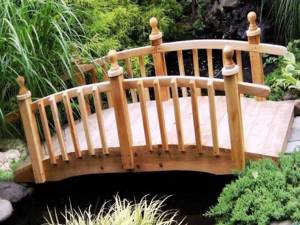
Such a bridge can easily support the weight of a person with a load.
The assembly diagram is shown in the sketch below.

The scheme with arches may seem too complicated for building a decorative structure in a summer cottage. There is some truth in this, since it is quite difficult to cut two identical arcs - stringers - from a timber, or more often from a package of inch boards, without using a machine. It is much easier to get rid of arcs altogether and reduce the rounding of the beams almost to a straight line.
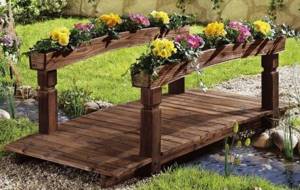
In this case, it is better to make a small decorative bridge with your own hands from the remnants of lumber used in the renovation of the cottage. In this design, the main element is the massive railings, which bear most of the load. Therefore, it is not worth saving on them, even for the sake of the decorative qualities of the entire structure.
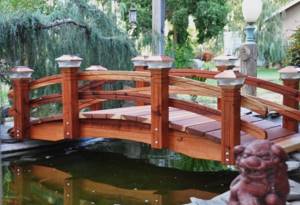
Decorative suspension bridge
Designs that do not use load-bearing arches are easier to manufacture. Sometimes a dacha needs not so much a decorative bridge as a functional one, one that is reliable and capable of withstanding the water pressure of a large stream. If you build a full-fledged bridge on a permanent basis, you can use the design shown in the photo above. You just need to take care of additional load-bearing supports, as in the drawing.

If the soil on the banks of the stream is rocky, then a suspension bridge can be built. It is simpler and more convenient to construct; you only need to dig in four vertical supports made of logs or steel pipe. The remaining parts are made of slats, planks and thick polypropylene rope. Such a bridge can be deployed for the summer season and removed to the dacha in late autumn after finishing work in the garden.
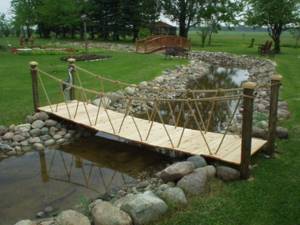
Metal bridge
You can build a crossing over a stream or pond using steel pipes or profiles. For example, a good solution for making a metal decorative bridge is shown in the drawing below.

The supporting frame is welded from two sections of square pipe, section 50x50 mm. The flooring is assembled from wooden planks 50 mm thick. The railings and supporting beams have additional struts, so the bridge of this design is openwork and quite strong; it can be installed without additional supports, even across a decorative pond in the country.

If you need to ensure primarily decorative qualities, then the structure can be built forged or from a bent profile. Such a decorative bridge for the garden, built with your own hands, photo, will be a real decoration of the landscape.
Installation materials
Often, when building structures on a summer cottage, people prefer wood, but there are other materials that look very attractive in landscape design. For example, stone bridges harmonize perfectly with flower beds and dry streams.

Stone bridge
Concrete structures are suitable for a garden decorated in a Gothic style.
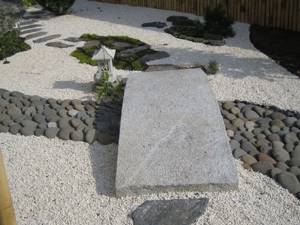
Concrete structure
Let us consider in detail the most popular and sought-after designs.
Forged bridges
Forging is a very expensive pleasure that only a professional blacksmith, a master of his craft, can recreate with his own hands. Of course, you can buy individual elements and try to assemble the structure yourself on your own site. But this should not be done - the bridge must be safe and durable, and only a specialist can guarantee these qualities.

These products are rightfully considered classics of landscape design, which remain in demand to this day. This is an excellent option to decorate a small summer cottage, especially since forging looks great in any design.
Wooden bridge
Wood is the most popular and inexpensive material, which is environmentally friendly and affordable. Ease of use, the ability to assemble a bridge with your own hands and repair it if necessary - wood has all these advantages.

How to make a decorative mini-bridge from thick branches at the dacha
For the first experiments with landscape design, it is best to use not lumber, but the remains of firewood and dead wood. You can take cuttings of branches and dry tree trunks; there is always plenty of this goodness at any dacha. Perhaps even use tree roots or build your own decorative bridge from driftwood for a pond.
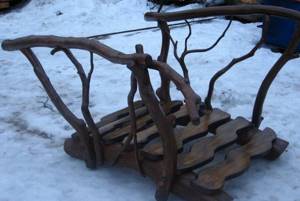
To work, you will need a pair of branches with a diameter of at least 10-12 cm, always with a pronounced curvature.
We assemble the decorative bridge in the following order:
- The most difficult part is to select the same segments on each of the branches. The length of each arch must be at least 120 cm. We cut out the blanks and lay them on a log template;
- Next you need to cut the strip for the flooring. As cladding we will use cuts made with a chainsaw along a dry tree trunk;
- We cut out the posts and railings from ordinary branches and nail them to the arches of the bridge.
The structure can be opened with drying oil or oil varnish. It is better to select the color and method of finishing to match the decorative design of the cottage.
Concrete bridge
A concrete bridge will last much longer, but will therefore be more expensive. For a concrete bridge, you can use purchased elements, but you can cast it yourself.
Concrete supports in the amount of four to eight are installed on both edges of the ditch. Or you can use concrete slabs placed on edge as supports. A sand cushion 20 centimeters thick is poured under the concrete supports. Concrete slabs are installed on top of the supports. That's it, the work on installing the concrete bridge is completed.
You can, of course, do without any bridge by installing a metal pipe at the bottom of the ditch under a car crossing or pedestrian path. On the one hand, it will be easier, on the other, less beautiful. What to use, of course, is up to you.
How to make a decorative wooden bridge with your own hands
Most gardeners and vegetable gardeners at their dacha always have a supply of lumber, edged boards and just remnants of lining. All this accumulates over the years and is often used in beds and gardens. If you additionally buy ten meters of timber 75x75 mm, a two-inch board with a width of at least 120 mm, look in the storerooms in the garage for M12x120 bolts, cut an inch board 150x900 mm, then it is quite possible to build a full-fledged bridge that will serve in the country for many years.
If this is your first attempt to make something out of wood yourself, then the best option to build a decorative bridge for the garden with your own hands is shown in the photo.
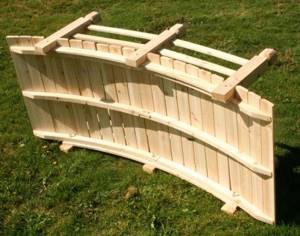
Important! The most complex part of the structure is the load-bearing arches; unlike other models, they are made by gluing two parts. This simplifies the process and does not require the use of expensive wide boards.
Each of the two arch beam segments is cut to a template from a two-inch board using a jigsaw or band saw, then glued and bolted together with wide washers.
The technical process for constructing a decorative bridge consists of the following operations:
- We cut blanks from a 10 cm board - for striping the flooring, each plank 25 mm thick and 12 cm wide is sawed to a size of 90-95 cm, on one side we remove the chamfer from the edges;
- We cut out 6 pieces of blanks to make segments of three arched beams. Each section is trimmed at one end with a wedge, and at the other – sawed to form a tenon. We glue the blanks together, tighten them with a bolt connection and place them under the load;
- We saw off blanks for the decorative fencing of the bridge. Each post is a 40x70 mm block, 60 cm long. We also cut 110-120 cm strips for decorative railings;
- To assemble a decorative bridge, you need to lay out three arches on a flat surface; any work table or even a bench in the country will do. We equalize the distance between the arched beams and fill two planks in the center and along the edges of the bridge;
- We bolt the vertical posts of the railing on each side of the bridge, and stuff the remaining planks.
All that remains is to install decorative railings on the bridge posts and open the structure with protective varnish or, better yet, deck impregnation based on paraffin oil.
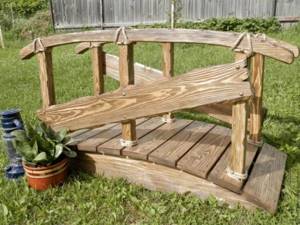
Knitted bridge is used for decorative purposes only
Birch bridge
Make a decorative bridge for the garden with your own hands from birch timber. Wood is a beneficial building material - environmentally friendly, beautiful, and easy to process. The use of various methods of influencing birch timber will allow you to change the appearance of the material and its texture.
The simplest option is a crossover structure. It can be combined with both a landscaped garden interior and a small artificial pond.
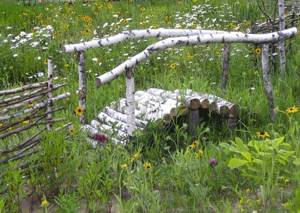
The structure does not require reinforced reinforcement. It does not need a concrete base or earthen piles. The exception is reservoirs with a high bank.
As a basis for a birch product, take wooden beams with a cross section of 30-35 cm. Round the logs - remove excess wood from a straight piece. Use a jigsaw or chisel.
Attach decking beams to the beams. Their thickness is at least 40 mm. Place the logs evenly around the perimeter of the beams. Butt them close to each other or make gaps - it all depends on your preferences and imagination.
Advice! Before starting assembly, dry the birch well. Treat with an antiseptic and apply a water-repellent agent.

Before construction, design the structure and make a drawing. Do not forget about the small elements of the structure - reliable fastenings, clamps for railings and balusters, balusters and beams.
How to make a decorative bridge from logs with your own hands
It is clear that there is no point in buying rather expensive debarked tree trunks to make a bridge. At any dacha in the garden you can find dry trunks that can be easily cut into logs or logs.
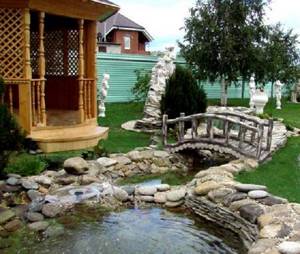
We assemble the base of the decorative bridge from two massive trunks. If there is not enough suitable material at the dacha, then the supporting arches can be knocked down with nails from thinner branches. This is the most difficult part of the project; if increased demands are placed on the decorative appearance of the structure of the future bridge, then it is better to bring the base for the bridge to the dacha separately from the nearest forest plantation.
The decking for the decorative bridge can be made from logs; they must first be selected and calibrated by diameter. Next, we lay them on the arches and nail them. For railings, you can use almost any branches or trimmings of logs that can be found in the country.
Types of designs
Installing a bridge on the site has not only an aesthetic, but also a practical function. Bridges are installed where it is necessary to step over something or go around an obstacle. Among the various types of designs, the following can be distinguished:
- Wooden;
- Bamboo;
- Stone;
- Metal;
- Concrete.

These are the most used materials in the construction of vertical structures and elevations. They are freely available, so constructing a bridge with their help is not difficult.
Bridges are also divided into those that can be walked on, and those that carry only a decorative load. Decorative options are usually small. They are made in those places where it is necessary to diversify the monotonous landscape as much as possible with interesting accents.
Wooden
Wood products fit naturally into any landscape. They harmoniously complement the space around, making the appearance of the site even more interesting. The advantages of wooden structures include such aspects as:
- Ease of preparation and assembly;
- Eco-friendly material;
- Lightness of design;
- Long service life;
- Wide possibilities for decoration.

The most common wood for such bridges is pine. More expensive options are made from oak, ash and cedar. The wooden bridge can be painted in any color. Its shape can be made more sloping or flat. Repairing such a bridge will not cost much.
Bamboo
Bamboo structures look gentle and delicate. They fit perfectly into the landscape design of the garden and open area. If there is an eastern corner at the dacha, then the bamboo version of the bridge will come in handy.
A Japanese-style area simply won't look complete if it doesn't have a bamboo bridge. The lightweight and airy material is durable enough to withstand long-term use. And its appearance reminds of the beauty of oriental gardens and parks.
Stone
Stone options are considered one of the most durable. They fit perfectly into the European landscape style. They look solid and presentable. Such bridges combine well with other stone structures on the site.

The simplest option for a stone bridge is to place stone blocks over a stream or pond. An antique style landscape will require more delicate work. Therefore, marble or granite can be used here. And the structure itself can be erected using publicly available drawings and cement.
Metal
Metal bridges will decorate the site in the Gothic style. They are also suitable for modern style. And forged options combine perfectly with romantic notes in the landscape of the site.
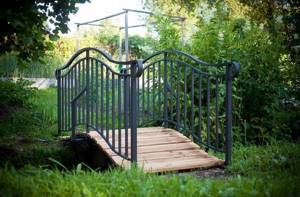
Metal structures can be purchased at a specialized store, or you can weld them yourself. This type of bridge has a long service life. Not afraid of serious temperature changes. Easily combined with other materials.

Metal for creating a bridge is suitable for those who do not like change. The material can last on the site for decades. And changing its shape is quite difficult. Therefore, metal bridges will appeal to true conservatives.
Concrete
Concrete products are among the most durable decorative items. Fountains and artificial water tanks will be installed next to them to highlight the beauty of concrete bridges. To make such a bridge high, you need to build metal reinforcement into its structure. Low options can be created from solid concrete blocks.
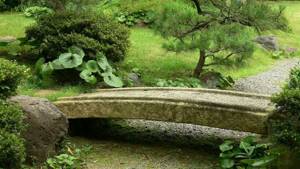
Concrete bridges not only have a decorative function; you can safely walk on them and transport a cart with tools. A properly designed bridge can withstand significant loads.
How to make a decorative metal bridge without welding with your own hands
It would seem that the optimal solution for the garden would be a metal version of the bridge. This design will be more durable, reliable, does not require maintenance and protection from rain. The only problem is that the electrical wiring at the dacha is not always suitable for connecting a welding machine.
You can make a decorative bridge without welding; for this you will have to use square pipes and a double clamp type connection. In this way, load-bearing frames for fences made of corrugated sheets are assembled.

It can also be used to assemble a decorative bridge. Moreover, it can be done even with the weakest electrical wiring in the country; all you need is an electric drill and a grinder.
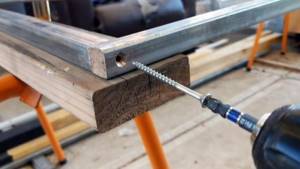
True, the frame of the metal bridge turns out to be too rectangular and somehow unsightly.
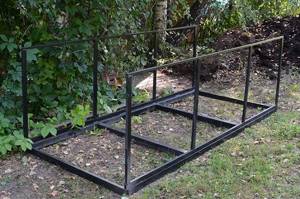
How to make a decorative bridge from a profile pipe
The ability to use a welding machine greatly simplifies the work. The strength of bolted connections cannot be compared with welding. Moreover, when the decorative bridge is regularly used for its intended purpose, the nuts tend to unscrew under load, even if lock washers are used in the connection.
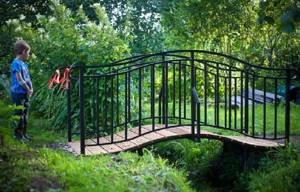
The production of a decorative bridge will have to be planned right at the dacha; for these purposes it will be necessary to deliver to the site:
- Tools – an angle grinder, a welding inverter with a couple of dozen quarter electrodes, a set of clamps. You can take a device for bending profile pipes for work in the country or bend them in advance in the garage;
- Materials – bent pipe in the amount of 4 pieces, square profile 30x30 mm – 6 pieces, 120 cm long. You will also need pieces of construction reinforcement with the largest diameter available at the dacha.
You will also need to stock up on a wooden plank, 25-30 mm thick, screws and paint. The set of tools and materials is not particularly cumbersome, so it is quite possible to bring it all to the dacha by car in one trip.
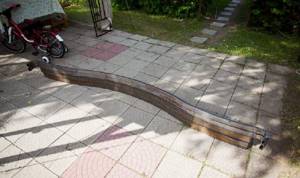
It is better to bend arches in a workshop
We weld the frame
If the arcs were bent professionally, and all four segments turned out to be identical in size and curvature, then no additional actions will be required. If the parts are slightly different, then you will first need to adjust the profile with hammer blows through a wooden spacer board.

Weld the frame in the following order:
- We choose a flat and dry area near the dacha. We lay out the arcs on a wooden lining in two bags, in pairs. In each package we collect two upper and two lower arches;
- We cut out the vertical posts with a grinder, and also lay them in pairs between the packages of the upper and lower arches;
- Using a tape measure, measure the diagonal distance between the corner points of the frame laid out on the site. We adjust and fix the position of the parts with clamps;
- We weld the parts of both halves of the decorative bridge with an inverter, after the parts have cooled, raise them to a vertical position and temporarily fix them with a cord and wooden slats.
All that remains is to weld a few horizontal cross members at the bottom, and you can paint. It is better to install a decorative bridge as soon as the paint has dried, before bad weather or vacation at the dacha prevents you from finishing what you started.
Installing a decorative bridge across a stream at the dacha
Before installation, you first need to strengthen and plan the sites on both banks. If there is sand and crushed stone at the dacha, you need to use them to fill the supports after installing the frame.

We move the decorative bridge to the chosen location, install it and adjust the height of the fill on the ground so that the structure stands level, without play. Next to the outer posts, we hammer the reinforcement into the ground with a sledgehammer; for reliable fixation, you need to drive the pins in at least half a meter. All that remains is to weld the bridge pillars to the reinforcement and paint over the weld seam.
The last detail is laying the flooring; we fasten the planks with metal screws. The wood on the back side and the lower arches of the bridge will need to be treated with mastic or tar, or any moisture-proof lubricant that is available at the dacha. Otherwise, the metal on the weld seams will quickly rot, and it will no longer be possible to repair it in the countryside.


